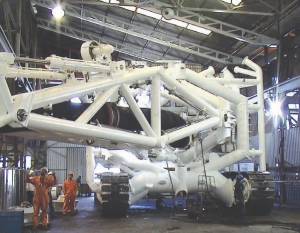KENILWORTH, SOUTH AFRICA–The Canadian lake-based mining industry has strengthened its position in the global market in recent years with the establishment of several new large mines that have led to Canada becoming a large producer of zinc and uranium.
As well, some of the world’s leading mining companies operate diamond mines in Canada, including De Beers’ Snap Lake mine, Rio Tinto’s Diavik mine and BHP Billiton’s Ekati mine.
Our company of South African-based marine engineers is investigating the possibility of adapting our existing underwater crawler technology, currently being used for marine diamond mining by De Beers off the coast of Southern Africa, for lake-based applications in Canada.
The idea is very much in the early stages and we still need to do further investigation, to consider aspects such as the environment, geology, climate, location of each mine, etc.
As we understand it, the mining of lake-based deposits involves the construction of massive concrete and stone dykes around the site. The area of lake within the dykes is then pumped dry to allow access to the lakebed.
We believe that it may be feasible to adapt our current marine diamond mining technology to mine the bottom of a lake without having to drain the water. This would mean that the mines would no longer have to build these huge dykes at vast expense or disrupt a lake’s ecosystem to reach the deposits.
An example of this is the Diavik diamond mine in Lac de Gras. Here, the dykes average 10 metres high but can get as high as 28 metres. In other instances, entire lakes are drained to access the mineral-rich deposits hidden beneath their depths. An example of this is Steep Rock Lake in northwestern Ontario, which required the dewatering of the lake with a surface area of about 13 sq. km, the diversion of a major river system, the lowering of nearby Finlayson Lake by 12 metres and the largest dredging project ever to be undertaken in Canada.
At Ekati, a string of lakes has been drained for shovel-and-truck, open-pit mining to take place in the exposed kimberlite bodies.
Understandably, the process of building these huge dykes and/or draining the lake is vastly expensive and time-consuming, plus this method of mining has a fairly large environmental impact on the area while the mine is in operation, with additional expense to rehabilitate an area once mining has ceased.
Our current marine technology consists of a 250-tonne remotely operated underwater crawler that is equipped to cut into the ocean bed and then vacuum up the diamond-bearing material which is pumped to the ship-based treatment plant through a 650-mm internal diameter rubber hose using a 2.4-megawatt dredge pump system. A 500-kilowatt hydraulic power pack powers the systems on the crawler.
A pilot and co-pilot operate the crawler through a system of 12 computer monitors that provide readings on production, oil and water levels, pressures and temperatures, etc. In addition, the pilots see a virtual animation of the movements of the crawler, the seabed and the mining process.
One crawler can extract about 400 tonnes per hour, or 2.5 million tonnes of product per year.
If it’s possible to mine the bottom of the ocean with this technology, then why not the bottom of a lake? Any lake-based deposits can potentially be mined using our crawler technology, so this adaptation possibly applies to uranium, zinc, gold, copper, nickel and so on.
We believe that this idea is feasible and has the potential to greatly assist and enhance the industry. –The author is managing director of Marine and Mineral Projects, a South African-based firm of marine engineers.


Be the first to comment on "Creepy crawlers for Canada?"